
 Introduction
Introduction
 History
History
 Morphology
Morphology
 Adults
Adults
 Immature Stages
Immature Stages
 Terminology
Terminology
 Phylogeny
Phylogeny
 Distribution
Distribution
 Ecology
Ecology
 Biology
Biology
 Collecting
Collecting
 Determination
Determination
 Photography
Photography
 References
References
|
 WOOD (1981): "Small (3 mm) to very large (over 50 mm) flies, averaging 9-15 mm in length, long and slender to short, robust, and bee-like."
WOOD (1981): "Small (3 mm) to very large (over 50 mm) flies, averaging 9-15 mm in length, long and slender to short, robust, and bee-like."
LEHR (1988): "Body size of adult insects range from 3 to 80 mm."
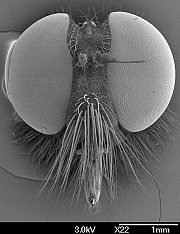 WOOD (1981): "Head compound, eyes large, usually widely separated, equally so in both sexes; eye facets enlarged medially; eye extending dorsally above level of vertex, causing vertex to appear excavated when viewed anteriorly; ocellar tubercle prominent; median ocellus enlarged; vestiture of ocellar tubercle of fine pile, often mixed with bristles. Frons short in Laphystiini, Laphriini, and Atomosiini, but higher in Stichopogonini, varying from a narow transverse band to half height of head. Face more extensively developed than in other Asilomorpha, exceptionally high in most species, often convexly protuberant (gibbous); facial protuberance, or gibbosity, with a characteristic group of stout anteroventrally directed hairs or bristles, the mystax, arranged as a cluster on lower part of face; mystax in some genera extending over entire face to antennal bases, in others reduced to a transverse row along lower margin of face. Clypeus reduced, concave or flat, folded posteroventrally below lower facial margin.
WOOD (1981): "Head compound, eyes large, usually widely separated, equally so in both sexes; eye facets enlarged medially; eye extending dorsally above level of vertex, causing vertex to appear excavated when viewed anteriorly; ocellar tubercle prominent; median ocellus enlarged; vestiture of ocellar tubercle of fine pile, often mixed with bristles. Frons short in Laphystiini, Laphriini, and Atomosiini, but higher in Stichopogonini, varying from a narow transverse band to half height of head. Face more extensively developed than in other Asilomorpha, exceptionally high in most species, often convexly protuberant (gibbous); facial protuberance, or gibbosity, with a characteristic group of stout anteroventrally directed hairs or bristles, the mystax, arranged as a cluster on lower part of face; mystax in some genera extending over entire face to antennal bases, in others reduced to a transverse row along lower margin of face. Clypeus reduced, concave or flat, folded posteroventrally below lower facial margin.
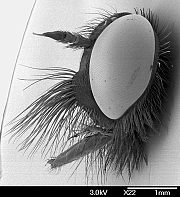 Antenna held erect; scape and pedicel each usually with long or short pile, often with stout bristles; first flagellomore elongate or oval, clavate in a few genera, pubescent or tomentose but without pile or bristles, usually longer than either scape or pedicel especially in Dasypogoninae. A bent apical or subapical stylus usually present on first flagellomere, typically two-segmented (the very small second and more elongate third flagellomeres), occasionally one-segmented, apparently absent in Laphriinae; shape varying widely throughout the family, elongate and thickened in most Dasypogoninae, forming a long bristle-like structure in Asilinae, elongate and as thick as first flagellomere in Myelaphus Bigot and Ceraturgus Wiedemann, and plumose in the asiline tribe Ommatiini. A minute spine, often in a pit, present at apex of antenna on either the first or succeeding flagellomeres.
Antenna held erect; scape and pedicel each usually with long or short pile, often with stout bristles; first flagellomore elongate or oval, clavate in a few genera, pubescent or tomentose but without pile or bristles, usually longer than either scape or pedicel especially in Dasypogoninae. A bent apical or subapical stylus usually present on first flagellomere, typically two-segmented (the very small second and more elongate third flagellomeres), occasionally one-segmented, apparently absent in Laphriinae; shape varying widely throughout the family, elongate and thickened in most Dasypogoninae, forming a long bristle-like structure in Asilinae, elongate and as thick as first flagellomere in Myelaphus Bigot and Ceraturgus Wiedemann, and plumose in the asiline tribe Ommatiini. A minute spine, often in a pit, present at apex of antenna on either the first or succeeding flagellomeres.
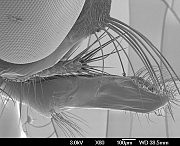 Mouthparts similar in both sexes, unlike those of biting (bloodsucking) Nematocera and Tabanomorpha, uniquely adapted for stabbing and sucking prey. Mandible absent; stabbing function performed by needle-like hypopharynx that injects a paralyzing saliva. Proboscis elongate, heavily sclerotized, formed from ventromedial fusion of prementum and labella as a continuous tube open at apex and dorsomedially, and enclosing maxillae and hypopharynx; tip of labella pointed or rounded, usually surrounded with sensory hairs; ventral surface of labella and most of prementum pilose. Palpus usually slender or clavate, setose, two-segmented in all Dasypogoninae with a small basal segment hidden among dense vestiture of the subcranium and with an elongate clavate or lamellate apical segment, or one-segmented in all Asilinae and Leptogastrinae with the basal segment missing or fused to the apical segment."
Mouthparts similar in both sexes, unlike those of biting (bloodsucking) Nematocera and Tabanomorpha, uniquely adapted for stabbing and sucking prey. Mandible absent; stabbing function performed by needle-like hypopharynx that injects a paralyzing saliva. Proboscis elongate, heavily sclerotized, formed from ventromedial fusion of prementum and labella as a continuous tube open at apex and dorsomedially, and enclosing maxillae and hypopharynx; tip of labella pointed or rounded, usually surrounded with sensory hairs; ventral surface of labella and most of prementum pilose. Palpus usually slender or clavate, setose, two-segmented in all Dasypogoninae with a small basal segment hidden among dense vestiture of the subcranium and with an elongate clavate or lamellate apical segment, or one-segmented in all Asilinae and Leptogastrinae with the basal segment missing or fused to the apical segment."
LEHR (1988): "Head flattened, transversely rounded or slightly oblong, mobile; eyes are over most of head anteriorly and laterally. Vertex excavated between eyes; eyes not contiguous."
MAJER (1997): "Head is relatively short and broad with more or less convex occiput, freely moveable. Eyes: compound eyes are huge, bulging forward and upward usually widely separated on top of the head by a deep trough that is feature of robber-flies; compound eye is divided two parts, one at the rim of the eye are small other having larger facets situated in the central part, ocellar tubercle prominent; fore ocellus enlarged; ocellar tubercle pilose, often with bristles. Near the posterior margin of the eyes often one or more rows of strong bristle like occipital setae. Frons various, short in Laphystiini, Laphriine, and Atomosiini, but higher in Stichopoginini, varying from a narrow transverse stripe to very wide, about half height of head. Face well developed, often convexly prominent (gibbous); facial protuberance, or gibbosity, bearing a bruch of setae; the mystax (face beard) may extend to the antennae and laterally to the eyes margin, they sometimes may be reduced to a single row of setae at the mouth margin (epistoma). Clypeus reduced, concave or flat, folded posteroventrally below lower facial margin.
Antennae vary in form in different subfamilies and genera; scape and pedicel each usually with long or short hairs, often with strong bristles; first flagellomere elongate or oval, style or arista sometimes with a terminal spine or bristle, usually longer than either scape or pedicel especially in Dasypogoninae, plumose in the Ommatiinae.
The mouthparts consist of a strongly sclerotized (proboscis) including the active mouth-parts: the labium and maxillae which form a food canal, labrum and the piercing organ, the hypopharynx. At the tip of hypopharynx haired at the dorsal margin. Proboscis rounded in cross section or laterally or dorsoventrally compressed, stout, varying length and form, mostly straight, rarely recurved, i.e. in Ancylorrhynchus, uniquely adapted for stabbing and sucking prey. Palpus lies at the base beside the labium, two-segmented in all Dasypogoninae or single segmented in Asilinae and Leptogastrinae, usually slender or clavate, setose."
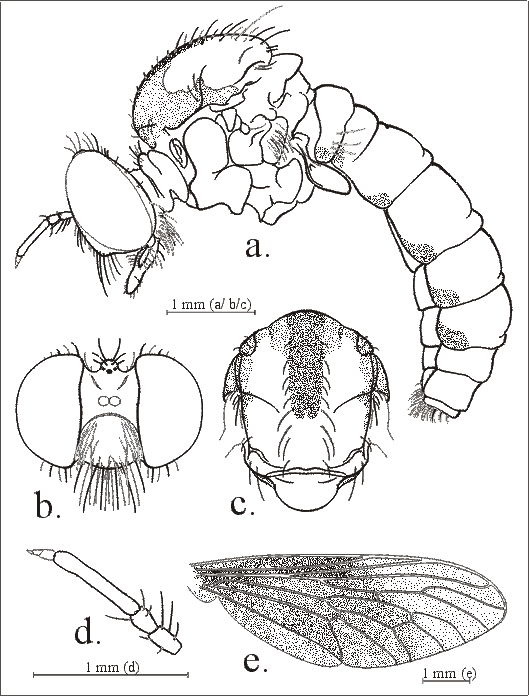 Paraphamartania stukei
Paraphamartania stukei Geller-Grimm, 1997, female. - a. head, thorax, abdomen in lateral view (only with the tomentum on mesoscutum and tergites); - b. head in frontal view; - c. thorax in dorsal view; - d. antenna in lateral view; - e. right wing.
WOOD (1981): "Thorax: sclerites varying somewhat in shape, fusion, vestiture, and chaetotaxy. Antepronotum often with a tranverse furrow separating an anterior ridge on which bristles or pile are located; postpronotum bare in some genera or pile or long bristles in others; poststernum fused with proepisternum either forming a precoxal bridge in Laphystiini, Laphriini, Atomosiini, and some genera of other groups, or separated by membrane in the remaining genera. Notopleural, supra-alar, and postalar bristles almost always present; dorsocentral bristles usually present. Scutellum usually pruinose but sometimes shiny, almost always with hairs or bristles along its margin especially at apex; katatergite almost always with a row or group of bristles (absent in subgenus Stenopogon Loew); anatergite (lateral slope of metanotum of Hull 1962) bare in most Dasypogoninae and in one group of Asilinae (Promachus Loew, Efferia Coquillett and allied genera), or with hairs or bristles in most other Asilinae. Metepimeron usually with pile on its posterodorsal corner, occasionally bare (Stichopogonini and a few other genera); posterior edges of metepimera sometimes extended posteromedially to meet and fuse in midline forming a postmetacoxal bridge in Atomosiini, Ommatiini, and isolated genera in Dasypogoninae, postmetacoxal region membranous in other genera.
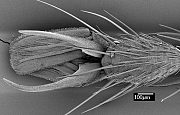 Legs, as befits a predatory insect, raptorial stout, frequently with numerous stout bristles; all tibiae with several stout bristles at apices; a modified apical bristle, usually termed fore tibial spine, present on fore tibia of some members of Dasypogoninae (Dasypogonini sensu Hull 1962), either stout, thickened, and arising from a spine-like process on the apex as in Saropogon Loew, or thin and twisted as in Cophura Osten Sacken. First tarsomere of hindleg enlarged in a few genera, much longer and wider than succeeding segments (e.g. Holopogon Loew); claws strong and sharp in most groups, but blunt in the asiline genus Mallophora Macquart and allied genera; pulvilli usually present, although absent in Leptogastrinae and in a few genera of Dasypogoninae (e.g. Ablautus Loew); empodia bristle-like, lost in the leptogastrine genus Psilonyx Aldrich and in some Leptogaster Meigen.
Legs, as befits a predatory insect, raptorial stout, frequently with numerous stout bristles; all tibiae with several stout bristles at apices; a modified apical bristle, usually termed fore tibial spine, present on fore tibia of some members of Dasypogoninae (Dasypogonini sensu Hull 1962), either stout, thickened, and arising from a spine-like process on the apex as in Saropogon Loew, or thin and twisted as in Cophura Osten Sacken. First tarsomere of hindleg enlarged in a few genera, much longer and wider than succeeding segments (e.g. Holopogon Loew); claws strong and sharp in most groups, but blunt in the asiline genus Mallophora Macquart and allied genera; pulvilli usually present, although absent in Leptogastrinae and in a few genera of Dasypogoninae (e.g. Ablautus Loew); empodia bristle-like, lost in the leptogastrine genus Psilonyx Aldrich and in some Leptogaster Meigen.
Wing venation much as in Tabanidae, Rhagionidae, and Therevidae, not highly modified; R always four-branched, with R2+3 unbranched; recurrent spur or stump vein occasionally extending proximally towards base of wing from R4 near base, incomplete in some genera (e.g. Efferia) but extending proximally to meet R2+3 in Promachus and a few related genera; all veins proceeding to wing margin independently in many Dasypogoninae and most Leptogastrinae; cell r1 closed, i.e. R2+3 joining R1 before reaching C in Asilinae and Laphriinae; in the latter three groups M3 meeting CuA1 and CuA2 meeting A1, before the wing margin, thereby closing cells m3 and cup; in Dasypogoninae and Leptogastrinae, some genera with either cell cup or cell m3 closed [e.g. Holcocephala Jaennicke (Damalini), some Prolepsis Walker], occasionally with both closed [e.g. Microstylum Macquart]; sometimes, in various genera throughout family except Leptogastrinae, M1 joining R5 before reaching wing margin [e.g. Perasis Hermann, Cerotainiops Curran, and some Mallophorina Curran]; rarely, M2 or M3 not reaching wing margin, reducing number of cells as in Itolia Wilcox and Townsendia Williston (Dasypogoninae). Strongly thickened costa-like hind margin absent in a few genera (e.g. Itolia). Alula well-developed except in Leptogastrinae and few genera of Dasypogoninae (e.g. absent in Dioctria Meigen). Wing most often hyaline, but partly infuscated in many genera (e.g. Asilus Linnaeus), or completely darkened and bifurcations as in Nicocles Jaennicke and Eucyrtopogon Curran.."
LEHR (1988): "Thorax massive. Legs strong and seizing. Wings narrow. Costal vein of most species decurrent along margin of wing; 4 radial, 3 medial and 2 cubital veins."
MAJER (1997): "Thorax stout, sclerites stout and thick, varying in shape, fusion, vestiture, and chaetotoxy. Pronotum often with a transverse furrow separating an anterior ridge on which bristles or hair is developed, postpronotum bare or haired sometimes with bristles. Mesonotum often, in a few species bare, shining, patterned, mostly haired and setosus. Notopleural, supra-alar, and postalar bristles mostly present. Scutellum pollinose or shiny, mostly with bristles or bristle like hairs along its margin, mostly at the apex.
Legs: powerful and rather long, femora stout and swollen, frequently bear strong and erect bristles. Tibiae slender, broadened at the apex in some genera and with apical spines; Claws mostly strong and sharp in most genera; pulvilli mostly present, (absent in Leptogastrinae). Number of Tarsal segments 5.
Wings: the wings are rather narrow for speedy flight. Venation much as in Tabanidae, Rhagionidae, and Therevidae; R always four-branched, with R2+3 unbranched; recurrent spur or stump vein occasionally extending proximally toward base of wing from R4 near base extending proximally to meet R2+3 in Promachus and a few related genera; all veins proceeding to wing margin independently in many Dasypogoninae and most Leptogastrinae; cell r1 closed and stalked, i.e. R2+3 joining R1 before reaching C in Asilinae and Laphriinae; in the latter three groups M3 meeting CuA1, and CuA2 meeting A1, before the wing margin, thereby closing cells M3 and cup; in Dasypogoninae and Leptogastrinae, M1 joining R5 before reaching wing margin (Dasypogoninae). Alula well-developed except in Leptogastrinae and a few genera of Dasypogoninae (e.g., absent in Dioctria Meigen). Wing most often hyaline, but sometimes smoky or dark coloured, or partly infuscated in many genera (e.g. Asilus Linnaeus), or completely darkened in a few genera. The alula and posterior angle well developed, except in Leptogasterinae. Halteres normal."
WOOD (1981): "Abdomen hemicylindrical, often tapering, sometimes clavate, often slightly narrower at junction with thorax and widest at segments 2-4, gradually narrowing distally to apex, in some groups (e.g. Mallophora and related genera) stout, widened, and shortened mimicking various bees or wasps, and in Leptogastrinae usually slender, very elongate, and clavate. Pile on abdominal tergites somewhat sparse except in groups mimicking bees, longer on posterolateral corners, most abundant on tergite 1 which usually has differentiated external bristles, and often reduced or absent on second and succeeding tergites. Eight segments usually present in both male and female, with the remaining two segments incorporated into terminalia. In male, tergite 8 often shortened and somewhat telescoped inside tergite 7; sternite 8 modified in shape also; segment 8 vestigal in a few groups (Laphriini and Atomosiini) in which segment 7 is also reduced, partly or totally concealed behind segment 6; only six segments visible in male of Laphystiini. In female of Asilinae and Laphriinae segment 8 incorporated into terminalia; sometimes segments 7 and 6 incorporated as well, as in Neoitamus Osten Sacken; in Laphriinae segment 7 shortened and narrowed; in most Dasypogoninae, sternite 8 modified in shape, with tergite 8 sometimes included in terminalia; in Leptogastrinae segment 8 not included, sometimes shortened but not otherwise much modified.
![Mallophora atra [Mound, 1990]](images/malat.gif) Mallophora atra
Mallophora atra
Male terminalia unrotated at emergence, except in Laphriini and Atomosiini in which they are rotated 180° permanently; rotation variable, up to 90° occuring during copulation in most Dasypogoninae or occurring before copulation in remaining Dasypogoninae, never rotated in Leptogastrinae and Asilinae. Epandrium entire, lobed or divided medially as epandrial lobes (superior forceps of Hull 1962). Hypandrium well-developed, secondarily reduced or absent; gonostylus arising from gonocoxite apically in Laphriini, basally in Asilinae, reduced or absent in Atomosiini; parameres fused to form an aedeagal sheath; aedeagus bulb- or funnel-shaped at base, narrowed to apex, single-tubed in most Dasypogoninae, trifid in Atomosiini, Laphriini, and most Asilinae, bifid in a few asiline genera, or with lateral tubes reduced or nonfunctional as in Polacantha Martin (Martin 1975). Surstyli (paralobus) of Hull 1962) present or absent, separate or fused medially; cerci (lamellae or proctiger of Hull 1962) partly to completely fused.
Female terminalia with tergite 8, or epigynium, reduced in size but unmodified in shape in most Dasypogoninae, incorporated into terminalia in Asilinae. Sternite 8, or hypopygium, bearing a pair of lobes, the hypogynial valves (interpreted by some authors, e.g. Cole and Wilcox 1938, as sternite 9). A pair of sclerites (interpreted as remnants of sternite 9 by Adisoemarto and Wood 1975) lying on either side of vagina, in some genera joined to each other by their anterior ends; tergite 9 obsolete medially, reduced to a pair of small sclerites (Adisoemarto and Wood 1975). Tergite 10 in most Dasypogoninae divided midlongitudinally into two plates called acanthophorites bearing five or more pairs of stout spines probably used for digging; in a few genera of Asilinae cerci with stout spines for depositing eggs in soil."
LEHR (1988): "Abdomen usually cylindrical, sometimes dorsoventrally flattened; 8 pregenital segments. Male genitalia can be turned around body axis about 180°. Aedeagus bears the essential specific characters and genera are seperable by the feature of dististyle. Ovipositor structure diverse, according to method of oviposition."
MAJER (1997): "Abdomen consists of 6-8 visible segments preceding the genitalia in males, but the eighth segment sometimes entirely or partially concealed, and terminal forming ovipositor. Regular longish and narrow, conical or stout widened and dorsoventrally flattened and shortened (mimicking various bees and wasps), in hemicylindrical cross section, often tapering, sometimes clavate, often slightly narrower at junction with thorax and widest at segments 2-4, extremely long and slender in Leptogastrinae. Most of them with almost bare abdomen, the first tergite usually bears strong setae laterally and strong setae at the posterior margin of other tergites and sternites. Dense hairs on abdominal tergites in groups mimicking bees. Eight segments usually present in both sexes, with the remaining two segments incorporated into terminalia. In male, tergite 8 often shortened and somewhat telescoped inside tergite 7; sternite 8 modified in shape; segment 8 vestigial in some groups (Laphriini and Atomosiini) in which segment 7 is also reduced, partly or totally concealed behind segment 6; six segments visible in male of Laphystiini. In female of Asilinae and Laphriinae segment 8 includes terminalia; in Laphriinae segment 7 shortened and narrowed; segments 7 and 6 incorporated in Neoitamus; in most Dasypogoninae, sternite 8 modified in shape, with tergite 8 sometimes included in terminalia; in Leptogastrinae segment 8 not. Genitalia mostly prominent and conspicuous in both sexes and in some species with a circlet of stout bristles at the tip of the ovipositor.
Terminalia (after Wood) Male terminalia rotated at emergence in Laphriini and Atomosiini, never rotated in Leptogastrinae and Asilinae.
Hypandrium various, well-developed, secondarily reduced or absent; gonostylus arising from gonocoxite apically in Laphriini, basally in Asilinae, reduced or absent in Atomosiini; parameres fused to form an aedeagal sheath; aedeagus bulb- or funnel-shaped at base, narrowed to apex, single-tubed in most Dasypogoninae, trifid in Atomosiini, Laphriini, and most Asilinae, bifid in a few asiline genera. Surstyli present or absent, separate or fused medially; cerci partly to completely fused.
Female terminalia with tergite 8, or epigynium, reduced in size but unmodified in shape in most Dasypogoninae, incorporated into terminalia in Asilinae. Sternite 8, or hypogynium, bearing a pair of lobes, the hypogynial valves (interpreted by some authors, e.g. Cole and Wilcox 1938, as sternite 9). A pair of sclerites (interpreted as remnants of sternite 9 by Adisoemarto and Wood 1975) lying on either side of vagina, in some genera joined to each other by their anterior ends; tergite 9 obsolete medially, reduced to a pair of small sclerites (Adisoemarto and Wood 19755). Tergite 10 in most Dasypogoninae divided midlongitudinally into two plates called acanthophorites bearing five or more pairs of stout spines probably used for digging; in a few genera of Asilinae cerci with stout spines for laying eggs in soil."
|



|